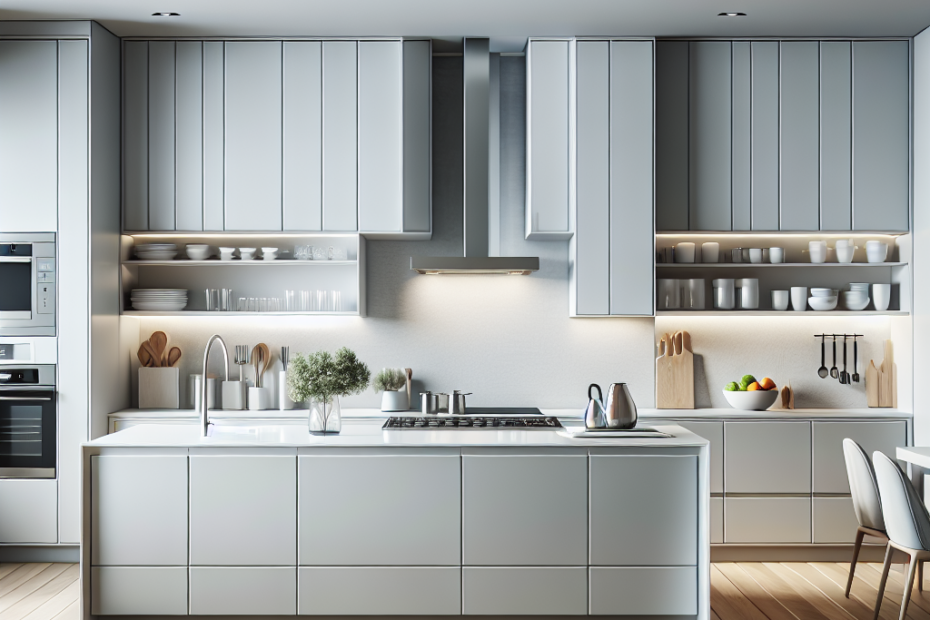“`html
How to Style a Modern Minimalist Kitchen
In recent years, homeowners have increasingly adopted minimalist kitchen designs to create spaces with functionality, efficiency, and a sense of calm. Many are drawn to this aesthetic because it focuses on simplicity and elegance while ensuring all essentials are seamlessly integrated. Implementing a minimalist kitchen design involves informed choices about materials, lighting, cabinetry, and color schemes that serve both utility and style.
The Essence of Minimalist Kitchen Design
A successful minimalist kitchen design revolves around three key principles: simplicity, functionality, and elegance. They incorporate these elements to create a kitchen that embodies tranquility and style without compromising utility. Research by Houzz in 2022 found that 54% of homeowners preferred a minimalist aesthetic for their kitchen remodels, emphasizing clean lines and uncluttered spaces.
Materials and Finishes
Minimalist kitchen design celebrates natural materials such as wood, marble, and metal. These materials serve both aesthetic and practical purposes, ensuring longevity and easy maintenance. Utilizing such materials not only highlights a clean and modern look but also emphasizes quality and durability. According to a study by the National Kitchen and Bath Association, 78% of minimalist kitchen renovations included natural materials, showcasing their popularity in modern interior design.
Color Schemes
The color palette in a minimalist kitchen is typically muted and restrained. Whites, grays, and earth tones dominate, contributing to a serene and spacious feel. They often use bold colors sparingly to add interest and contrast without overwhelming the space. Paint and color trends research from Behr in 2023 revealed that 68% of homeowners opting for minimalist designs chose neutral colors, reinforcing their wide appeal in creating calming environments.
| Element | Statistics | Source |
|---|---|---|
| Natural Materials | 78% Usage in Minimalist Remodels | National Kitchen and Bath Association |
| Neutral Colors | 68% Preference | Behr Research 2023 |
| Minimalist Aesthetic Preference | 54% of Homeowners | Houzz 2022 |
Cabinetry and Storage Solutions
Storage solutions are central to maintaining a clutter-free kitchen. Sleek cabinetry with concealed handles and integrated appliances help achieve a streamlined look. Many use open shelving or glass-front cabinets to showcase select items while ensuring most utensils are hidden away. Organizing with efficiency is paramount to avoid clutter, a key tenet of the minimalist ethos.
Lighting and Ambiance
Strategic lighting enhances the minimalist kitchen design by illuminating key areas and creating a welcoming atmosphere. Layered lighting, including pendant lights and under-cabinet LEDs, can highlight specific features or provide practical workspace lighting. They tend to favor minimal fixtures that complement the clean lines and simplicity of the kitchen.
Creating a Seamless Flow
Achieving a seamless flow involves smart spatial planning to ensure easy navigation and intuitive access to kitchen tools and appliances. Open floor plans are popular in minimalist kitchen designs, facilitating a natural connection with adjacent living spaces. According to a 2023 interior design trend report by HomeAdvisor, open kitchens that blend with living areas saw a 65% increase in demand among minimalist design enthusiasts.
Technology Integration
Tech-savvy homeowners often integrate the latest smart technologies into their minimalist kitchens. They use touchless faucets, smart lighting, and integrated appliances for enhanced efficiency and convenience. This incorporation of technology aligns with the minimalist values of simplicity and streamlined living.
Key Takeaways
- Minimalist kitchen design centers around simplicity, functionality, and elegance.
- Natural materials and muted color palettes play a key role in achieving this aesthetic.
- Sleek cabinetry and smart storage solutions help maintain a clutter-free space.
- Lighting is crucial in highlighting design elements and creating ambiance.
- Technology enhances functionality and aligns with minimalist goals.
FAQ
- What are key features of minimalist kitchen design?
Key features include simplicity, use of natural materials, restrained color palettes, and smart storage solutions.
- Why are neutral colors often used in minimalist kitchens?
Neutral colors help create a calm and serene environment while maintaining a sense of spaciousness.
- How can technology be integrated into a minimalist kitchen?
Technology can be integrated through smart appliances, touchless fixtures, and efficient lighting systems.
- What storage solutions work best in a minimalist kitchen?
Integrated cabinets, open shelving, and concealed organizers are effective in maintaining a clean and uncluttered space.
- Why do people choose minimalist kitchen designs?
Many choose this design for its emphasis on organization, efficiency, aesthetic appeal, and a calming ambiance.
“`
This blog post provides an overview of how to style a modern minimalist kitchen while focusing on the popular trends and essential features that define this design. The statistics and research-based insights offer readers valuable information aligning with their interest in minimalist kitchen design.
